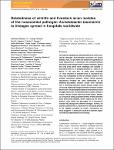Relatedness of wildlife and livestock avian isolates of the nosocomial pathogen Acinetobacter baumannii to lineages spread in hospitals worldwide
Wilharm, Gottfried
Skiebe, Evelyn
Higgins, Paul G.
Poppel, Marie T.
Blaschke, Ulrike
Leser, Sarah
Heider, Christine
Heindorf, Magdalena
Brauner, Paul
Jäckel, Udo
Böhland, Karin
Cuny, Christiane
Lopinska, Andzelina
Kaminski, Piotr
Kasprzak, Mariusz
Bochenski, Marcin
Ciebiera, Olaf
Tobolka, Marcin
Layer, Franziska
Bender, Jennifer K.
Fuchs, Stephan
Semmler, Torsten
Pfeifer, Yvonne
Jerzak, Leszek
The natural habitats and potential reservoirs of the nosocomial pathogen Acinetobacter baumannii are poorly defined. Here, we put forth and tested the hypothesis of avian reservoirs of A. baumannii. We screened tracheal and rectal swab samples from livestock (chicken, geese) and wild birds (white stork nestlings) and isolated A. baumannii from 3% of sampled chicken (n = 220), 8% of geese (n = 40) and 25% of white stork nestlings (n = 661). Virulence of selected avian A. baumannii isolates was comparable to that of clinical isolates in the Galleria mellonella infection model. Whole genome sequencing revealed the close relationship of an antibiotic-susceptible chicken isolate from Germany with a multidrug-resistant human clinical isolate from China and additional linkages between livestock isolates and human clinical isolates related to international clonal lineages. Moreover, we identified stork isolates related to human clinical isolates from the United States. Multilocus sequence typing disclosed further kinship between avian and human isolates. Avian isolates do not form a distinct clade within the phylogeny of A. baumannii, instead they diverge into different lineages. Further, we provide evidence that A. baumannii is constantly present in the habitats occupied by storks. Collectively, our study suggests A. baumannii could be a zoonotic organism that may disseminate into livestock.
No license information

